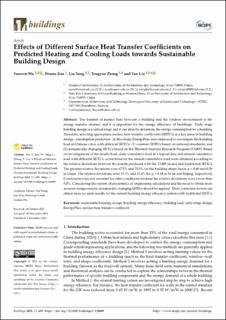| dc.contributor.author | Wu, Yanwen | |
| dc.contributor.author | Jian, Wenna | |
| dc.contributor.author | Yang, Liu | |
| dc.contributor.author | Zhang, Tengyue | |
| dc.contributor.author | Liu, Yan | |
| dc.date.accessioned | 2023-01-10T08:38:42Z | |
| dc.date.available | 2023-01-10T08:38:42Z | |
| dc.date.created | 2022-01-14T14:13:57Z | |
| dc.date.issued | 2021 | |
| dc.identifier.citation | Buildings. 2021, 11 (12), . | en_US |
| dc.identifier.issn | 2075-5309 | |
| dc.identifier.uri | https://hdl.handle.net/11250/3042174 | |
| dc.description.abstract | The transfer of surface heat between a building and the outdoor environment is the energy transfer channel and it is important for the energy efficiency of buildings. Early stage building design is a critical stage and it can directly determine the energy consumption by a building. Therefore, selecting appropriate surface heat transfer coefficients (SHTCs) is a key issue in building energy consumption prediction. In this study, EnergyPlus was employed to investigate the building load in Chinese cities with different SHTCs: (1) constant SHTCs based on national standards; and (2) dynamically changing SHTCs based on the Thermal Analysis Research Program (TARP). Based on investigations of the hourly load, daily cumulative load in a typical day, and annual cumulative load with different SHTCs, corrections for the annual cumulative load were obtained according to the relative deviations between the results produced with the TARP model and traditional SHTCs. The greatest relative deviations were 67.5% and 25.3% for the building shape factor φ = 0.49 and 0.29 in Lhasa. The relative deviations were 13.3% and 12.0% for φ = 0.49 in Xi’an and Beijing, respectively. Corrections were not essential for other conditions because the relative deviations were lower than 5.0%. Considering the current characteristics of engineering calculations and the need to obtain more accurate design results, dynamically changing SHTCs should be applied. These correction factors can obtain more accurate results for the current building energy efficiency system with traditional SHTCs. | en_US |
| dc.language.iso | eng | en_US |
| dc.publisher | MDPI | en_US |
| dc.rights | Navngivelse 4.0 Internasjonal | * |
| dc.rights.uri | http://creativecommons.org/licenses/by/4.0/deed.no | * |
| dc.title | Effects of different surface heat transfer coefficients on predicted heating and cooling loads towards sustainable building design | en_US |
| dc.title.alternative | Effects of different surface heat transfer coefficients on predicted heating and cooling loads towards sustainable building design | en_US |
| dc.type | Peer reviewed | en_US |
| dc.type | Journal article | en_US |
| dc.description.version | publishedVersion | en_US |
| dc.source.pagenumber | 0 | en_US |
| dc.source.volume | 11 | en_US |
| dc.source.journal | Buildings | en_US |
| dc.source.issue | 12 | en_US |
| dc.identifier.doi | 10.3390/buildings11120609 | |
| dc.identifier.cristin | 1981293 | |
| cristin.ispublished | true | |
| cristin.fulltext | original | |
| cristin.qualitycode | 1 | |

